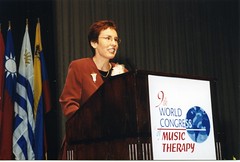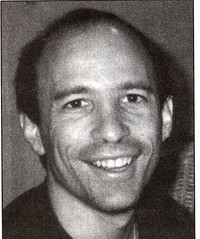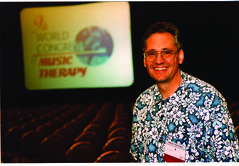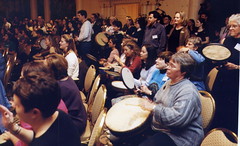9th World Congress of Music Therapy: Interview with Mary Adamek, Kenneth Aigen and Al Bumanis
Interviewed by Barbara Wheeler
Reflections from Mary Adamek, Conference Chair
How was it decided to have the World Congress in the U.S.?
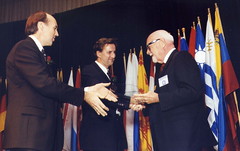
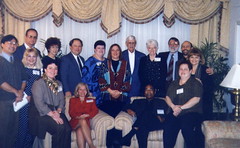
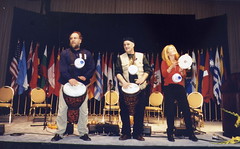
A previous board of directors, NAMT board, had decided to bid for the World Congress in 1999. I was not a part of that discussion. In fact, I remember after I was elected to serve as the first AMTA Vice President beginning in 1998, I realized that I would be conference chair for the inaugural AMTA conference in St. Louis and the World Congress in Washington, DC, in 1999. I had not had any experience with participation in previous World Congress events, so this was all new to me.
How was the planning of the congress organized? How did you become Chair of the congress? Who else helped? How was the U.S. music therapy organization involved?
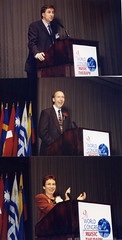
We had a Scientific Committee that was led by Ken Aigen. Michele Forinash was recently elected to be the first ever Vice President-elect, so she also worked with us on the leadership team to develop the program. We also worked closely with Tony Wigram, who was the President of the World Federation at that time. It was the first time I met Tony, and I am so glad that I was able to get to know him through the World Congress. I was Chair due to my role as AMTA Vice President, and since AMTA was the host we used our structure for conference planning. I worked closely with Dr. Andi Farbman and Al Bumanis on all aspects of the conference. Of course all of the national office staff contributed to the success of the conference. We also had a very large exhibit hall with lots of interesting information, instruments, and supplies for sale. I know that many of our international guests loved shopping in the exhibits since they might not have had such good access to high quality materials closer to home.
How was the congress itself organized? Were there plenary sessions and also smaller sessions?
While we utilized much of the basic structure of the annual NAMT/AMTA conference, we made many changes to accommodate the needs of the participants and the World Federation. We had all sorts of sessions, with several plenary sessions, concurrent sessions, panel discussions, research poster session, and for the first time ever, we launched the "clinical practice forum." The clinical practice forum was set up in a similar fashion to the research poster session, but focused on clinical interventions and clinical work. This also gave a larger number of participants an opportunity to present at an international conference.
We made a huge effort, in time and money, to provide Spanish translation and Spanish interpretation for much of the conference. All printed conference materials were in both English and Spanish. The large plenary sessions had simultaneous interpretation, as well as some of the concurrent sessions also had interpretation for the audience. This worked well in some instances, and in others not so well. As I mentioned, AMTA spent thousands and thousands of dollars on these services to make the experience as meaningful as possible to the larger music therapy community.
What kind of social activities were planned? How many people attended and from what countries?
From my memory, I seem to remember that we had about 2600 conference attendees from 46 different countries. Now this event was 12 years ago, so I might be off on my numbers! But we did have about 1000+ more people than usually attended the AMTA conferences. Sweet Honey in the Rock performed a concert, I believe on opening night. They were amazing. We also had a concert by Shirley Horn, who is a great jazz singer and pianist. Both concerts were well received by the audience, and since I was involved in planning, I was fortunate to sit in the front row! Those were really terrific events! There people perform all over the world to huge audiences and much acclaim, and we had them at our conference.
What were some of the highlights for you, both of the formal congress and informally/socially?
Many highlights for me, and I am sure many that I cannot remember! I loved meeting people from all around the world who gathered to share their passion for music and music therapy. It was exciting to stand on the podium at the opening session and see over 2000 people from so many countries. Musically, I would say the Sweet Honey concert was a true personal highlight, as I have followed their music for many years. I pushed myself professionally during this time, which I believe, contributed to my ongoing leadership in AMTA.
Memories prepared by Kenneth Aigen, Chairman of the International Scientific Committee
Any historical event can bear as many descriptions of it as there were participants in it. In reflecting on the Ninth World Congress of Music Therapy and its significance, I can only view it in terms of what was happening in the profession of music therapy in the US at that time.
In 1994, the two professional music therapy associations in the US—the American Association for Music Therapy (AAMT) and the National Association for Music Therapy (NAMT)—began exploring the possibility of unifying into one organization. This process of unification was completed on January 1, 1998, with the creation of the American Music Therapy Association (AMTA). I was a member of the Board of Directors of the new organization, representing the interests of the members of the former AAMT.
The new organization would be sponsoring the Ninth World Congress, although it was moved from its customary time in the July-August period to November to accommodate to the timing of the annual conference of the AMTA. As someone who had attended a variety of conferences and symposia in Europe (such as the World Music Therapy Congress in Spain in 1993, the International Symposium for Nordoff-Robbins Music Therapists in 1995, and a number of International Symposiums for Qualitative Music Therapy Research in Germany) and who had travelled in Japan, Australia, and New Zealand on music therapy tours, I was familiar with the functioning of international events and had a number of music therapy colleagues and friends throughout the world. I think that it was this connection to the international music therapy community that suggested I would be able to formulate a program that was in line with the expectations of this international community.
The interesting subtext here related to the ongoing domestic developments within music therapy in the US. While the members of the former AAMT being based in the east coast had more connections with European music therapists, many of the members of the former NAMT had been more focused on the domestic music therapy scene and were not so cognizant of international developments in music therapy. This conference would really represent an opening to the rest of the world for these individuals. So I was convinced of the importance of creating a program that would highlight the variety of advanced levels of practice throughout the world.
This led me to the idea of creating a special track in the congress highlighting “Five International Models of Music Therapy Practice.” My idea was to bring special attention to the models of Analytical Music Therapy (AMT), Guided Imagery and Music (GIM), and Nordoff-Robbins Music Therapy (NRMT), and to have the founders of each of these approaches attend the Congress and offer a special presentation together. Political considerations led to the expansion of the original focus to “Five International Models of Music Therapy” with Behavioral Music Therapy (BehMT)and Benenzon Music Therapy (BenMT) being added to the original three models. Dr. Kenneth Bruscia was asked to design and coordinate this special track which really was like a conference-within-a-conference, as it was comprised of pre-congress courses, a special plenary session, and a large number of presentations and panels that covered topics such as training, research, and various forms of clinical practice. It was very gratifying to be able to host almost all of the surviving members who had created these models: Rolando Benenzon (BenMT) Helen Bonny (GIM), Clifford Madsen (BehMT), and Clive Robbins (NRMT). Only Mary Priestley (AMT) was unable to attend and she was graciously represented by Johannes Th. Eschen. Seeing all of these visionary pioneers together in the special plenary session was one of the highlights of my own professional life.
In addition to these presentations, the quality of the music offered is strong in my memory.
The performances of jazz musicians Shirley Horn and Stanley Jordan, and the unique performance/presentation of classical pianist Lorin Hollander stand out for me. I also remember the panel presentation on “Performance and Product: Clinical Issues in Music Therapy” with participants Alan Turry, David Ramsey, Sten Roer, Raymond MacDonald, Emma O’Brien, and Peter Jampel. This panel really dealt with many of the issues that have come under the umbrella of “Community Music Therapy” and I think that it provided a strong impetus to this movement. One of my most enduring memories of the conference was a plenary presentation by Carolyn Kenny titled “The Sense of Art: A Rainforest of Strength.” Carolyn used words, pictures and music in a poetic and intellectual way to communicate the interconnectedness of all living things and she illustrated the relevance of this knowledge for music therapy. To me, this presentation, drawing upon the words and thoughts of indigenous people perfectly captured the idea of strength in the diversity, an idea that underlies the well-being of an eco-system but also one that is highly relevant in establishing the strength and resilience of an international discipline such as music therapy.
Memories from Al Bumanis
The weather in Washington DC was unseasonable mild, and attendees were able to get outside and enjoy the benefit of exploring the city, with only a few reports of muggings! Those are the kind of things that come to your attention when you are the main meeting planner for the event. I also remember being summoned to the Grand Ballroom just before a keynote address by Dr. Carolyn Kenny. A bird was flying lazily around the ballroom. I was shocked, but Carolyn saw it as a wonderful opportunity, probably not an accident, and had her flute at the ready to interact with nature. We also had procured a wonderful Grand Piano for use by the performers, which music therapists immediately discovered and would sneak onto the main stage throughout the night to play. Security would call me, let them play on.
My fondest memories go back to working with the many great individuals who made the conference happen, and the musical artists who we had perform. Dr. Mary Adamek was the conference chair. As the newly elected Vice President of the American Music Therapy Association she actually had to start in February of 2008 to plan 2 conferences simultaneously. Our 1998 Conference in Cleveland was the inaugural AMTA conference, with about 1,400 attendees, a very important event historically for music therapy in the USA. We had no idea that we would double that figure for the World Congress. Mary worked tirelessly to make both happen.
If I recall correctly over 400 submissions were reviewed by the scientific committee headed by Dr. Ken Aigen. The organization of the educational program with a focus on 5 “models” made for wonderfully collaborative spirit and a stimulating program. Dr. Tony Wigram, as president of the WFMT always brought to me a warm friendship, and his past experiences at World Congress’s were great lessons for me on what to expect. Many more people should be acknowledged, especially Dr. Andi Farbman, and the leaders of music therapy organizations from around the world.
I was very proud of the music we were able to showcase at the World Congress, from artists who remain friends of music therapy. Opening night featured Sweet Honey in the Rock, a magnificent musical journey into Afro-American and African song. For the opening reception we had music therapist Frank Wagner’s jazz trio. The next evening we presented master percussionist Glen Velez, followed by jazz guitarist Stanley Jordan, who was to become a music therapy student at Arizona State University. We had hired security guards to act as ushers and only let people in at appropriate time during the performances, to create a real concert atmosphere. No one knew that Stanley decided to improvise a medley with no formal breaks between songs. The pressure for people to get inside became too much, so in they charged to witness a mesmerizing performance. Our headliner was Shirley Horn, a jazz singer /pianist whose first teacher was music therapist Fran Hughes. Pianist Loren Hollander has featured the following evening, and Dr. Louise Montello brought her swing band for a swing dance. And of course music therapists made and shared their own music in the lobby, at the Cabaret and drum circle that had 800 plus participants.
I’m ready to do it again.

